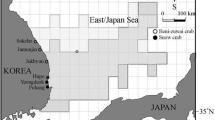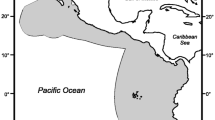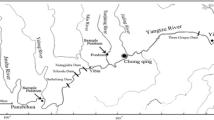Abstract
Commercially caught crayfish (Pacifasticus leniusculus) were placed in a municipal lake below a combined sewer overflow outfall and a storm drain outfall associated with elevated sediment metal concentrations. Abdominal muscle, viscera, and exoskeleton from each crayfish were analyzed for mercury, cadmium, lead, and copper. Crayfish metal concentrations for each sampling site were evaluated relative to unexposed samples from the commercial catch and samples held in the laboratory. Results indicated that 1) mercury accumulated in muscle tissue, highest cadmium concentrations were in the viscera, and highest lead concentrations were in the exoskeleton, 2) uptake of copper is well-regulated by the organism at non-toxic water concentrations, and 3) viscera concentrations of cadmium, lead, and copper tended to be higher and more variable than in muscle tissue. A significant correlation was found between body weight and muscle mercury concentration. Relative to allowable limits for metals in foods, there was not sufficient accumulation of any metal to indicate that a significant health hazard would result from consumption of these organisms. These data indicate that analysis of trace metals in various body parts ofP. leniusculus may be a useful biological indicator of trace metal pollution of freshwater lakes and streams.
Similar content being viewed by others
References
Abercrombie, F. N., M. D. Silvester, and R. B. Cruz: Simultaneous multielement analysis of biologically related samples with RF-ICP. In T. H. Risby (ed.): Ultratrace metal analysis in science and environment. Advances in Chemistry Series 172. Washington, DC: American Chemical Society (1979).
Anderson, R. V.: The effect of lead on oxygen uptake in the crayfishOrconectes virilis. Bull. Environ. Contam. Toxicol.20, 394 (1978).
Anderson, R. V., and J. E. Brower: Patterns of trace metal accumulation in crayfish populations. Bull. Environ. Contam. Toxicol.20, 120 (1978).
Anderson, R. V., W. S. Vinikour, and J. E. Brower: The distribution of Cd, Cu, Pb, and Zn in the biota of two freshwater sites with different trace metal inputs. Holarctic Ecol.1, 377 (1978).
Dickson, G. W., L. A. Briese, and J. P. Giesy: Tissue metal concentrations in two crayfish species cohabiting a Tennessee cave stream. Oecologia44, 8 (1979).
D'Itri, F. M.: The environmental mercury problem, Cleveland, OH: CRC Press, (1972).
Enk, M. D., and B. J. Mathis: Distribution of cadmium and lead in a stream ecosystem. Hydrobiologia52, 153 (1977).
Evans, M. L.: Copper accumulation in the crayfish (Orconectes rusticus). Bull. Environ. Contam. Toxicol.24, 916 (1980).
Gale, N. L., B. G. Wixson, M. G. Hardie, and J. C. Jennett: Aquatic organisms and heavy metals in Missouri's new lead belt. Water Resour. Bull.9, 673 (1973).
Gillespie, R., T. Reisine, and E. J. Massaro: Cadmium uptake by the crayfish,Orconectes Propinquus Propinquus (Girard). Environ. Res.13, 364 (1977).
Miller, G. C., and J. M. Van Hyning: The commercial fishery for freshwater crayfish,Pacifasticus leniusculus (Astacidae) in Oregon, 1893–1956. Research Reports of the Fish Commission of Oregon2, 77 (1970).
Potter, L., D. Kidd, and D. Standiford: Mercury levels in Lake Powell: Bioamplification of mercury in man-made desert reservoir. Environ. Sci. Technol.9, 41 (1975).
Sheffy, T. B.: Mercury burdens in crayfish from the Wisconsin river. Environ. Pollut.17, 219 (1978).
Thorp, J. H., J. P. Giesy, and S. A. Wineriter: Effects of chronic cadmium exposure on crayfish survival, growth and tolerance to elevated temperatures. Arch. Environ. Contam. Toxicol.8, 499 (1979).
Tomlinson, R. D., R. J. Morrice, Jr., E. C. S. Duffield, and R. I. Matsuda: A baseline study of the water quality, sediments, and biota of Lake Union. Municipality of Metropolitan Seattle, 821 2nd Avenue, Seattle, WA (1977).
Tomlinson, R. D., B. N. Bebee, A. A. Heyward, S. G. Munger, and R. G. Schwartz: Fate and effects of particulates discharged by combined sewers and storm drains. EPA-600-80-111, U.S. Environmental Protection Agency (1980).
Uthe, J. F., F. A. J. Armstrong, and M. P. Stainton: Mercury determination in fish samples by wet digestion and flameless atomic absorption spectrophotometry. J. Fish. Res. Board Can.27, 805 (1970).
Vermeer, K.: The crayfish,Orconectes virilis, as a indicator of mercury contamination. Can. Fld. Nat.86, 123 (1972).
Westöö, G.: Methylmercury as percentage of total mercury in flesh and viscera of salmon and sea trout of various ages. Science181, 567 (1973).
World Health Organization: Environmental health criteria No. 1—mercury Geneva, Switzerland (1976).
Author information
Authors and Affiliations
Rights and permissions
About this article
Cite this article
Stinson, M.D., Eaton, D.L. Concentrations of lead, cadmium, mercury, and copper in the crayfish (Pacifasticus leniusculus) obtained from a lake receiving urban runoff. Arch. Environ. Contam. Toxicol. 12, 693–699 (1983). https://doi.org/10.1007/BF01060753
Received:
Revised:
Issue Date:
DOI: https://doi.org/10.1007/BF01060753




